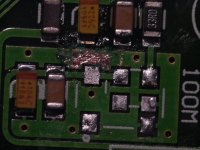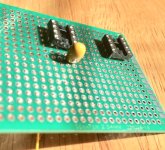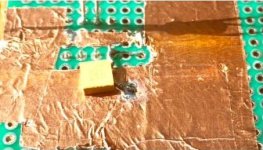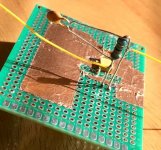Give a try to a Burson opa. Night and day....
Currently using LME49720. Good reasons for them, I think.
Interesting that Burson appears to refuse to provide a data sheet for the V6 op amp. High-ish distortion of the right type sounds good to some people, no question. I only seem to like it for electric guitars though.
Interesting that Burson appears to refuse to provide a data sheet for the V6 op amp. High-ish distortion of the right type sounds good to some people, no question. I only seem to like it for electric guitars though.
V5 can do a good job. There is no datasheet avaiable, but you talk about distortion. Did you ever hear a Burson stuff?
May I ask if anyone else besides me has been thinking abouts the output stage layout problem I posted yesterday?
I recently built the second iteration of Victors I/V.
Chinese ES9018K2M I2S DAC
sound and measurements are very much the same as for the one suggested above. I guess it might be optimal for this board - less space, fewer parts
V5 can do a good job. There is no datasheet avaiable, but you talk about distortion. Did you ever hear a Burson stuff?
No, at $100 or $120 for a dual opamp, it is too expensive for an experiment.
In the recording business there are many preamps, compressors, EQs, etc. that use the same approximate type of opamps or very similar. One is the Jensen twin-servo preamp circuit that uses discrete opamps. There have been different variations over the years, but in the recording biz, they may be referred to as 'colored pieces.' They are not deeply distorted like a fuzz box, but they are not 'clean' either. They impart some subtle color to the sound that was not there before, although it may be very nice. Given what is on the data sheet of the Burson v5 opamp, and the reluctance to publish one for v6, I think I get the drift. They are nice sounding colored pieces. Even the API console preamps fall into this category (good for drums though). No, thank you. Not my cup of tea for a dac.
BTW, I have a very nice class-A mic preamp that is a colored piece. Sounds great and is used on many records for vocals and acoustic guitars. Not so good for other instruments and sounds. Not the right coloration for those.
I recently built the second iteration of Victors I/V.
Chinese ES9018K2M I2S DAC
sound and measurements are very much the same as for the one suggested above. I guess it might be optimal for this board - less space, fewer parts
Perhaps. Also, less filtering though. My experiments indicate the same thing Allo has found with Katana dac, which is that we probably need more filtering for better sound quality, not less. Exactly how much is best I am not sure, but pretty sure we need to experiment with more.
In addition, I would suspect that when it comes down to maximum common mode distortion removal, a balanced circuit may perform a little better. I don't trust static distortion measurements to tell the whole story. Victor's measurements looked good at 1kHz using only caps for AVCC! Nobody I know of has found 3 x 1800uf caps alone can fully fix AVCC related sound quality issues if they compare it to better solutions, but it is more of a dynamic sound quality issue not static. Unfortunately, nobody I know of has actually compared the sound of Victor's output to a three opamp balanced design with filtering, when used with an otherwise fully modded dac (which is probably the most revealing). So, we just don't know on that, but based on the filtering issue alone I would still go with a three opamp design. In that regard, you would be more than welcome to join us in trying out a through hole component three opamp output stage if you would like, it would be great to have in on it too. 🙂 The more the better since we want everyone to have the best sound we think we can do.
Last edited:
just instALled the crystek , its hard but i thought it would be harder🙂
the sound improvement is audible, especially the bass 🙂
Wow, good for you Paul! I was afraid that might not be so much of a useful mod until other things had been done first. Congratulations on getting through it. If you can do that, I suspect you will find you can do most things including somewhat smaller SMD.
... Unfortunately, nobody I know of has actually compared the sound of Victor's output to a three opamp balanced design with filtering, when used with an otherwise fully modded dac (which is probably the most revealing)---
too much effort IMHO. with some rather simple mods, one can get a setup with close SQ to pretty highly praised commercial products utilizing the same DAC chip. and learn some things about these DACs and how to cook them, what is priceless, I believe.
for the slightly different setups: (1) LT3042-opamp buffer for AVCC/3 opamp I/V gives -93dB; (2) 2xdiscrete series regulators for AVCC/Victors I/V results in 92dB. Soundwise the last one has more bass. both are just quick setups with p2p soldering etc. the last thing I plan to try is combine AVCC from the first with I/V of the second. quite frankly I do not see the point to go beyond this. nevertheless, I admire your attitude to push it further.
@eziitis, I think I am just going for getting close to the SQ of a different highly praised commercial product, namely Benchmark DAC-3, which uses a closely related dac chip, not precisely the same.
Also, it may be that Allo Katana will turn out to move the goal posts a bit for what is expected of ES9038Q2M dac products.
However, I do understand what you are saying and do respect your choices. 🙂
EDIT: Thx for the AVCC info too, it is appreciated.
Also, it may be that Allo Katana will turn out to move the goal posts a bit for what is expected of ES9038Q2M dac products.
However, I do understand what you are saying and do respect your choices. 🙂
EDIT: Thx for the AVCC info too, it is appreciated.
Last edited:
@Markw4, good luck! just wonder how close one can get to this DAC3? there the dac chip is closely related but better, proprietary solutions implemented etc. so far I remember there was a talk about the importance of special Vref filtering and more.
there are just too many little things to consider, that one may run out of the time to listen to the music. at the end of the day, I rathrer stick to the old "the worst enemy of good is better" 🙂
there are just too many little things to consider, that one may run out of the time to listen to the music. at the end of the day, I rathrer stick to the old "the worst enemy of good is better" 🙂
Last edited:
...just wonder how close one can get to this DAC3?
We are not, and cannot get, all the way there. Let's get that out of the way first. But, it is a really good target to work towards for those of us still making lesser Sabre-based dacs.
Right now it is easy to tell the difference between DAC-3 and a fully modded Q2M dac if one tries. However, turn up the volume a little and get half way across the room so there is some room sound in the mix, and it the listening experience can be virtually the same.
The main difference to me is that DAC-3 has less low level audible distortion. It does have a sound, I think. That seemed quite obvious the moment it replaced the old DAC-1. The sound quality was immediately better, but there was still some sense of it sounding like a box of electronics, just a very good sounding one.
I want to stress that the above is my opinion only. There are people who doubt such small imperfections can be audible at all, and there have been no formal studies that really demonstrate otherwise. Of course, my understanding from conversions here in the forum with Earl Geddes, someone who has published some pretty good hearing research, is that we probably have a pretty good idea of what about 95% of the population can hear, but the most sensitive or most skilled, whatever it is, 5% have never really been studied because nobody wants to pay for the research (which tends to be expensive).
Don't know if places like diyaudio have have more than the typical percentage of the overall population's 5%. Also, I kind of suspect but I don't think it has been studied that old men who tend to become, say, audiophiles may have gone though a late age-related reorganization of brain processing of sound. Part of that could have to do simply with neural compensation in response to some hearing loss of high frequencies and low volume level sounds. Have not seen research on precisely that, and it might be that you are reading related speculation here first. Don't know.
I say I suspect some of the above because of my own age, hearing loss, and other changes I notice in how I hear. For one thing, most of my life I had no memory for pitch (although I could always hear distortion quite well). I could not memorize a pitch for even a few seconds and correctly know for sure if I heard the same musical pitch a short time later. That has changed for the better in the past few years, but not due to anything I have consciously done so far as I can tell. My best guess would be it is an effect of age-related hearing neuroplasticity. Once more, this is speculation and opinion, nothing more. But, my best guess is there is probably something to it, or something close to it.
Okay. I got off topic a bit after starting off trying to respond to a question about how close we can come to DAC-3. I thought some of the above might be interesting to others, so I went on anyway. I will end here by saying I think we are getting really, really close to the point where a fully modded Q2M would be okay with me if I didn't have DAC-3 to listen to. How's that?
Last edited:
Getting back to actual dac modding again, and with regard to the through hole component output stage board, I would like to put up few pics to show conceptually (once again) how I would probably be inclined to do my layout if prospective builders think it will be okay, something they can do.
First picture shows a filter cap on top of the board but hopefully not too close to the socket. Second picture shows where the cap is attached to a socket pin, as is a smaller value ceramic cap (which might have been more out of the way if flipped around). There is also a hole between where the tantalum lead comes down and the socket. A power wire might come down there, or it might be soldered to the tantalum lead on top. Third picture shows an exaggerated example of a resistor, cap, and some signal wires connected to two opamp pins. If I were to do something like that for real I would try to make the leads much shorter, but I just wanted to show the idea. Also, I might fold the assembly over and lay it down next to the board, which might be mechanically preferable.
Also shown are a few strips of copper foil with the seams not yet soldered together. But, that is about how they should go, all around the opamp and between the rows of pins (I left out a piece in the foreground, but one should be there). Really small ceramic bypass caps might be soldered to that thin strip if no room elsewhere.
So, question would be, is this type of thing doable for beginners who don't want to do SMD?
First picture shows a filter cap on top of the board but hopefully not too close to the socket. Second picture shows where the cap is attached to a socket pin, as is a smaller value ceramic cap (which might have been more out of the way if flipped around). There is also a hole between where the tantalum lead comes down and the socket. A power wire might come down there, or it might be soldered to the tantalum lead on top. Third picture shows an exaggerated example of a resistor, cap, and some signal wires connected to two opamp pins. If I were to do something like that for real I would try to make the leads much shorter, but I just wanted to show the idea. Also, I might fold the assembly over and lay it down next to the board, which might be mechanically preferable.
Also shown are a few strips of copper foil with the seams not yet soldered together. But, that is about how they should go, all around the opamp and between the rows of pins (I left out a piece in the foreground, but one should be there). Really small ceramic bypass caps might be soldered to that thin strip if no room elsewhere.
So, question would be, is this type of thing doable for beginners who don't want to do SMD?
Attachments
Last edited:
Hey Markw4, which mastering of Aja do you have?It is just a snippet from Steely Dan's Aja album. That was perhaps the cleanest of their productions, and something many recording engineers have said they use as a reference if going after a particular kind of sound.
The 1984 US MCA CD (MCAD-37214) ?
The 1985 Japan MCA CD (32XD-112) ?
The 1988 Mobile Fidelity Sound Lab CD ?
Or the 2010 SACD ?
So, question would be, is this type of thing doable for beginners who don't want to do SMD?
No problems with that Mark.. looks eminently doable.
Interesting question.Hey Markw4, which mastering of Aja do you have?
It says copyright 1999
Remastered by Roger Nichols
088 112 056-2
I think there are some people that have complained about the sound of the cymbals on this version, but I find it very dependent on the dac. If the dac is good enough they really sound like cymbals in terms of the little details, and in terms of each cymbal having its own distinctive character. Makes it good for comparing dacs, and it is enjoyable to listen to on a good one.
Last edited:
... I will end here by saying I think we are getting really, really close to the point where a fully modded Q2M would be okay with me if I didn't have DAC-3 to listen to. How's that?
Indeed, the mods of this board reveal the power of Sabre DAC, which was hidden due to distortions. At the moment I prefer discrete regs/Victor I/V setup because the sound appears richer. Nevertheless, I start to feel the improvements also bring up the weakness of Sabres. The resolution is incredible and when listening in headphones even though the scene is pretty wide, more blending would be appreciated. AK DACs sound more natural and musical in headphones but are somehow less dynamic.
eziitis, I think I remember now you said you use software DSD256. If so, my next question would be to see if you are set up to access the dac registers? If so, it would be interesting to see how much you can reduce DPLL bandwidth, and the effects of harmonic distortion compensation.
Trouble is, when one says Sabre dacs have particular characteristics compared to AKM, it seems like there is a wide range of results that can be gotten out of either one. So, maybe you are talking about, or thinking of, implementations that are closer to being on the minimal side?
Just that some people who work with this equipment every day say they can't tell or can't decide if Benchmark DAC-3 sounds better than Crane Song Solaris, or vice versa. Too close to be sure, they say. Yet, one is Sabre and the other is AKM. Probably, both are running DSD in some clever way, and both using very good clocking schemes too. Solaris might have the upper hand with clocking.
Trouble is, when one says Sabre dacs have particular characteristics compared to AKM, it seems like there is a wide range of results that can be gotten out of either one. So, maybe you are talking about, or thinking of, implementations that are closer to being on the minimal side?
Just that some people who work with this equipment every day say they can't tell or can't decide if Benchmark DAC-3 sounds better than Crane Song Solaris, or vice versa. Too close to be sure, they say. Yet, one is Sabre and the other is AKM. Probably, both are running DSD in some clever way, and both using very good clocking schemes too. Solaris might have the upper hand with clocking.
Last edited:
Ah, that would be the 1999 remaster -It says copyright 1999
Remastered by Roger Nichols
088 112 056-2
Steely Dan - Aja (CD, Album) at Discogs
which had a certain amount of compression applied, probably to make it sound as loud as contemporary music releases of that time.
As you might expect, purists on the Steve Hoffman forum generally dislike this version ... but if the cymbals, to which you refer, are on the "bright" side, this may certainly be a good test for a DAC - to reproduce the bright cymbals without offending your ear too much!
So, question would be, is this type of thing doable for beginners who don't want to do SMD?
Yes it is really doable job for me.
Thank you Mark!
Will you publish the complete bill of material?
You bought every composant at Mouser?
- Home
- Source & Line
- Digital Line Level
- ES9038Q2M Board




